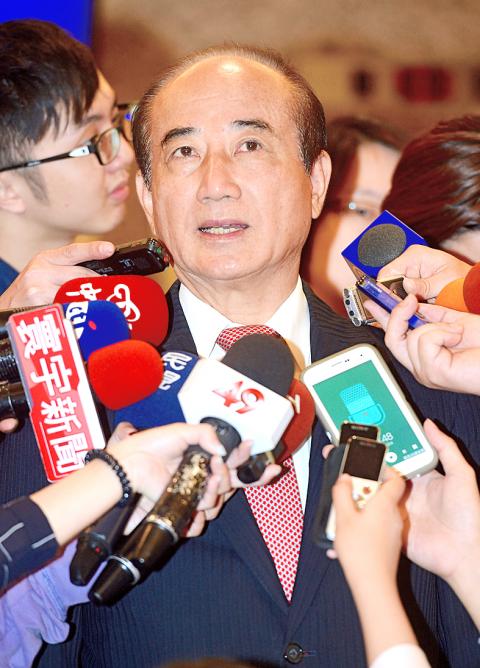The Chinese Nationalist Party’s (KMT) Central Standing Committee yesterday passed a motion to lift a self-imposed term limit on legislator-at-large seats for legislative speakers, opening the door for Legislative Speaker Wang Jin-pyng’s (王金平) potential re-election for a fourth term.
The proposal, jointly submitted by five committee members, was passed with the signatures of 29 of the 39 members, without being put to a vote at a routine meeting of the committee in Taipei.
The motion recommends an amendment be made to Article 2 of the KMT’s regulations on nominations for legislators-at-large and overseas legislators, which stipulates that KMT legislators-at-large are generally allowed to serve one term, but those with special contributions to the party are eligible for re-election.

Photo: Lo Pei-der, Taipei Times
The last paragraph of the article — dubbed the “legislative speaker clause” — states that KMT members who meet the above criteria and also serve as legislative speakers are entitled to a third term as a legislator-at-large.
The “legislative speaker clause” was added to the regulations in October 2011, before the end of Wang’s second term as legislator-at-large, for the apparent sole purpose of allowing him to retain his role for a third consecutive term.
Wang first assumed the speakership in 1999.
Under the new amendment, KMT legislative speakers who fulfil requirements would be exempted from the three-term limit.
“The legislative speakership is held by a legislators-at-large whose power and influence are accorded by their party. As such, their neutrality and authority might be compromised and questioned if their party can strip them of their position at will … or block their re-election bid by imposing a term limit,” the motion stated.
“In an effort to let the party’s legislative speaker fulfil duties without distractions, we propose that the committee make an amendment to the nomination regulations for legislators-at-large,” it added.
KMT spokesperson Lin Yi-hua (林奕華) said the committee did not discuss any specific KMT member or the party’s potential legislator-at-large candidates for the Jan. 16 elections at the meeting.
Prior to the meeting, KMT presidential candidate Eric Chu (朱立倫) said ensuring neutrality in the speakership was one of the three legislative reforms he plans to push for, if he wins the presidential race.
“The other two planned reforms include improving the efficiency of the legislature and improving transparency in legislative negotiations,” Chu said.
None of the three reforms would be affected because of a single individual, Chu said.
“My objective is to establish a long-term system. Any KMT members who disapprove of, or refuse to accept, these pending changes will not be nominated by the party as its candidates,” he added.
Wang said on the sidelines of an event in Taipei that the passage of the motion indicated support from leaders of both the KMT and the Democratic Progressive Party for a neutral legislative speaker and a reformed legislature.
“The public also looks forward to seeing these plans become a reality,” Wang said.

The US government has signed defense cooperation agreements with Japan and the Philippines to boost the deterrence capabilities of countries in the first island chain, a report by the National Security Bureau (NSB) showed. The main countries on the first island chain include the two nations and Taiwan. The bureau is to present the report at a meeting of the legislature’s Foreign Affairs and National Defense Committee tomorrow. The US military has deployed Typhon missile systems to Japan’s Yamaguchi Prefecture and Zambales province in the Philippines during their joint military exercises. It has also installed NMESIS anti-ship systems in Japan’s Okinawa

‘WIN-WIN’: The Philippines, and central and eastern European countries are important potential drone cooperation partners, Minister of Foreign Affairs Lin Chia-lung said Minister of Foreign Affairs Lin Chia-lung (林佳龍) in an interview published yesterday confirmed that there are joint ventures between Taiwan and Poland in the drone industry. Lin made the remark in an exclusive interview with the Chinese-language Liberty Times (the Taipei Times’ sister paper). The government-backed Taiwan Excellence Drone International Business Opportunities Alliance and the Polish Chamber of Unmanned Systems on Wednesday last week signed a memorandum of understanding in Poland to develop a “non-China” supply chain for drones and work together on key technologies. Asked if Taiwan prioritized Poland among central and eastern European countries in drone collaboration, Lin

NO CONFIDENCE MOTION? The premier said that being toppled by the legislature for defending the Constitution would be a democratic badge of honor for him Premier Cho Jung-tai (卓榮泰) yesterday announced that the Cabinet would not countersign the amendments to the local revenue-sharing law passed by the Legislative Yuan last month. Cho said the decision not to countersign the amendments to the Act Governing the Allocation of Government Revenues and Expenditures (財政收支劃分法) was made in accordance with the Constitution. “The decision aims to safeguard our Constitution,” he said. The Constitution stipulates the president shall, in accordance with law, promulgate laws and issue mandates with the countersignature of the head of the Executive Yuan, or with the countersignatures of both the head of the Executive Yuan and ministers or

CABINET APPROVAL: People seeking assisted reproduction must be assessed to determine whether they would be adequate parents, the planned changes say Proposed amendments to the Assisted Reproduction Act (人工生殖法) advanced yesterday by the Executive Yuan would grant married lesbian couples and single women access to legal assisted reproductive services. The proposed revisions are “based on the fundamental principle of respecting women’s reproductive autonomy,” Cabinet spokesperson Michelle Lee (李慧芝) quoted Vice Premier Cheng Li-chiun (鄭麗君), who presided over a Cabinet meeting earlier yesterday, as saying at the briefing. The draft amendment would be submitted to the legislature for review. The Ministry of Health and Welfare, which proposed the amendments, said that experts on children’s rights, gender equality, law and medicine attended cross-disciplinary meetings, adding that